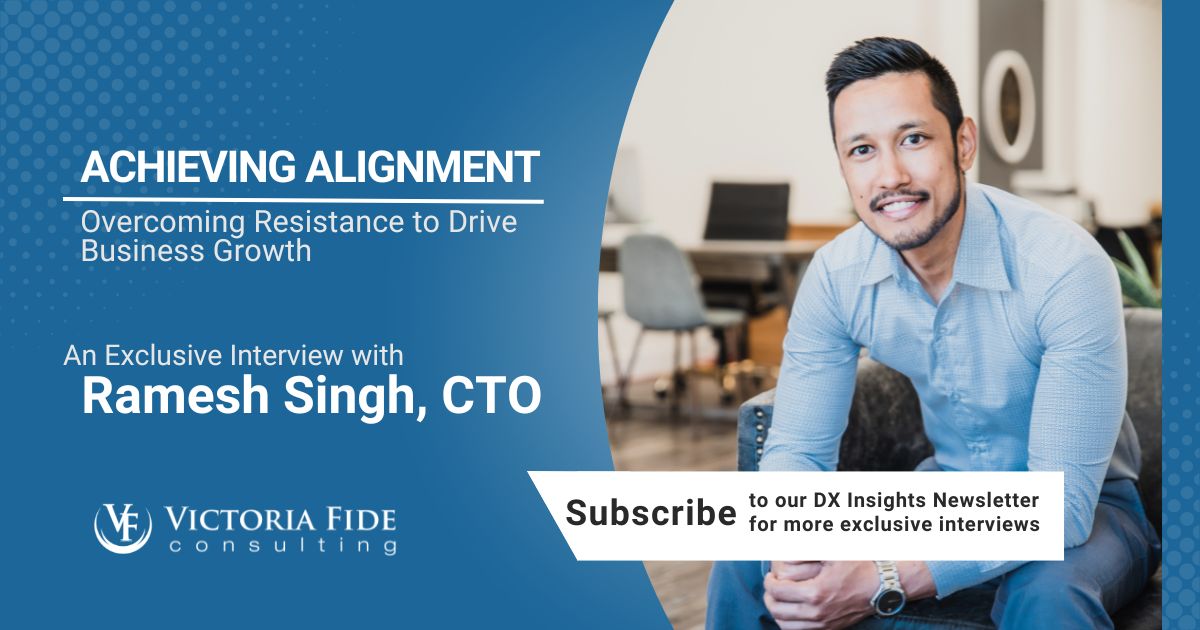
In the rapidly evolving world of digital transformation (DX), leaders who can harness technology to redefine the landscape of their industries are more valuable than ever. Ramesh Singh is one such visionary. With a rich background spanning over a decade in Information Technology, Singh has navigated various critical roles, ultimately leading to his current position where he serves as the founder and CTO of Victoria Fide Consulting. His diverse experience, ranging from Software Engineering to Enterprise Architecture, uniquely positions him to spearhead digital innovation and transformation efforts.
Throughout this DX Insights interview, Ramesh Singh shares invaluable insights gained from his extensive career. He candidly discusses the challenges and triumphs encountered on this journey, reveals his top advice for organizations on the cusp of their digital transformation, and forecasts future trends and potential hurdles in the field. Singh’s passion for utilizing technology not just as a tool but as a strategic asset shines through, offering readers a glimpse into the mindset required to thrive in today’s digital-first business world.
Table of Contents
As a Chief Technology Officer, you’ve likely encountered resistance from stakeholders when implementing new technologies or processes. How do you overcome these objections to ensure successful adoption?
In my role, encountering resistance or skepticism from stakeholders during the implementation of new technologies or processes is not uncommon. After all, we know how much organizations love change!
I have found that skepticism often arises from a lack of clarity or understanding about the proposed changes. To navigate and overcome these objections, I prioritize clear communication and transparency. This involves actively listening to stakeholders’ concerns, understanding their perspective, and tailoring my responses accordingly. Many times, the concerns are valuable input for requirements & design of the solution.
Also, I emphasize articulating the value proposition of the proposed changes. I make sure to demonstrate how these changes align with the organization’s overarching goals and objectives, emphasizing the potential benefits they bring.
Lastly, when feasible, I choose to implement proof of concepts or pilot projects to highlight the effectiveness of the proposed solutions; these initiatives have the potential to transform skepticism into optimism among stakeholders.
What are some common pitfalls you’ve observed in organizations undertaking digital transformation, and how do you advise overcoming them?
One of the most universal challenges I have seen is the lack of complete understanding of the transformation impacts, leading to a lack of preparedness for the change. To address this challenge, it is crucial to do an assessment of current state, including existing processes, technology landscape, and current infrastructure etc. Just as with any journey, it is important to know the starting point of your transformation.
These assessments help identify impacted processes, applications, and systems, as well as areas for improvement. This will help develop a comprehensive transformation plan.
How do you assess an organization’s current state of technology infrastructure and processes to determine the most effective strategies for digital transformation?
After completing our assessment and thoroughly documenting the current technology architecture, systems, and processes, we dive into the exciting phase of analyzing all this information. This is where we go through all the information to find opportunities for transformation.
Our approach prioritizes the organization’s objectives as we search for transformation opportunities. By identifying pain points and areas of potential improvement, we develop tailored transformation roadmaps that prioritize investments and initiatives for maximum impact.
It is important to recognize that navigating through the changes brought by transformations is not always easy, but it is necessary for staying competitive and future-proofing the business.

Transformation is not easy, but it doesn’t have to be impossible. Take control of your project’s success today and schedule a free 30-minute consultation to find out how Victoria Fide can equip you for transformational success.
In your experience, what are the most critical factors for ensuring successful alignment between an organization’s IT strategy and its overall business objectives?
To ensure successful alignment between an organization’s IT strategy and its overall business objectives, it is important to have a clear understanding of business objectives and priorities while building the IT strategy and roadmap. IT enabled capabilities need to align closely with business objects and priorities, matching the timelines.
Close collaboration and communication between IT and business stakeholders facilitate alignment by ensuring shared understanding and commitment to common objectives. Think of it as making sure everyone is reading from the same playbook!
Additionally, regular reviews help maintain alignment over time and adapt to changing business conditions. This helps us stay aligned as the business landscape shifts and changes.
Discuss a specific instance where the alignment between IT strategy and organizational objectives was particularly crucial. What steps did you take to ensure technology initiatives were aligned with the broader goals of the company?
One specific instance happened during a retail company’s rollout of a new point-of-sale (POS) system. They were trying to figure out the best credit provider option for their customers: considering two external providers or third option was in-house credit. But time was tight and to align with POS rollout, getting the infrastructure and integrations ready for credit processing via POS was becoming urgent.
Realizing how tough it was for the business to choose in the midst of market uncertainty, we took action. We kicked off the implementation project, focusing on common elements and making sure we could reuse work if things shifted. We also decided that if required, we will assume the most likely path to make decisions and move forward. Our CEO, Tory Bjorklund, calls this method CBA (Current Best Approach). CBA allows us to move forward with an assumed best answer, when we do not yet have the answer.
This approach gave the business the breathing room they needed to finalize their analysis and pick the best credit provider for their customers. By staying in the loop about their ongoing analysis, we could adjust our strategy to avoid redoing a bunch of work. In the end, we got the project done on time and within budget, even surpassing customer expectations and adding significant value to the business.
How do you approach the task of optimizing business performance through technology solutions, particularly in industries that may have unique challenges, constraints or prevalence for legacy drag?
We have had extensive experience in the manufacturing industry where outdated systems are common, and many companies lag behind other sectors like retail in terms of transformation. To tackle these challenges, we have learned that a one-size-fits-all approach will not cut it. We need to tailor our strategies to fit each company’s unique constraints and opportunities.
This might mean updating old systems, bringing together different data sources, or implementing advanced analytics tools to uncover valuable insights and guide decision-making.
Interestingly, I have found that resistance to change often comes more from people than from technology itself. That is why we put a strong emphasis on organizational change management and creating a culture that encourages innovation and experimentation. When employees feel empowered to try new things, it leads to ongoing improvements and a more adaptable workforce.
As a believer in finding solutions to every problem, can you share an example of a particularly complex or seemingly unsolvable issue you’ve encountered with a specific client, and how you approached resolving it?
There was an instance when working with a manufacturing company, and going through a wave of transformation efforts, multiple projects were centered around achieving a 360-degree view of our customers, which was quite ambitious.
The challenge was that all the relevant data was scattered across on-premises legacy systems, each operating in isolation. While a phased approach is typically recommended for such large-scale transformations, in this case it would require building integrations that would eventually be thrown away. Our technological landscape pushed us towards a big-bang approach.
Taking on such a sizable initiative that impacted multiple departments and their daily operations posed significant challenges. Simply coordinating meetings and aligning project timelines across various departments proved to be a daunting task. However, we navigated these complexities by managing all tactical aspects in accordance with our defined execution methodology.
This approach also demanded strong engagement from all stakeholders to convey the vision behind the journey. We needed everyone to understand why we were embarking on this transformation and the long-term benefits it would bring to their organization in terms of collaboration between departments, better tools, and access to information to serve their customers.
What advice would you give to organizations just beginning their journey of digital transformation, based on your experiences and lessons learned?
If I were to distill my advice for organizations embarking on the digital transformation journey, I’d say it’s crucial to start with a clear vision and strategy. Understand ’what’ you want to achieve and more importantly ‘why’ it’s important for your organization.
Next, prioritize collaboration and communication across all levels of the organization. Digital transformation isn’t just an IT project; it’s a company-wide endeavor. Get buy-in from leadership and involve SMEs from various departments to ensure everyone feels invested in the process.
Don’t be afraid to take calculated risks and embrace innovation. I have chosen to build products on newer technologies a few times, and it’s proven to be beneficial. Digital transformation often involves trying new technologies and approaches. Be open to experimentation and learn from both successes and failures along the way.
Invest in talent and skills development. Equip your team with the knowledge and resources they need to succeed in this new digital landscape. This might involve training programs, hiring new talent, collaborating with partners, and fostering a culture of continuous learning.
Finally, remember that digital transformation is not a destination, it’s a journey – unfortunately, a never-ending one! Be adaptable and willing to pivot as needed. The technology landscape is constantly evolving, so your strategy should evolve with it.

Looking ahead, what do you see as the biggest opportunities and challenges in the field of digital transformation, and how do you plan to address them as one of the founders of Victoria Fide?
Looking ahead, the field of digital transformation presents both significant opportunities and challenges for organizations seeking to innovate and thrive in an increasingly digital world.
I see the emergence of groundbreaking technologies like artificial intelligence, augmented reality/virtual reality (AR/VR), 3D printing, the Internet of Things (IoT), and advanced data analytics, as major drivers of digital transformation – enabling new business capabilities and value propositions.
However, realizing the full potential of these technologies requires addressing critical challenges. Within our company, we prioritize the continuous learning and development of our people, ensuring they are adept and up-to-date to provide informed guidance to our clients. Furthermore, we cultivate strategic partnerships with organizations offering pioneering solutions, enabling us to adeptly guide our clients through these challenges.
